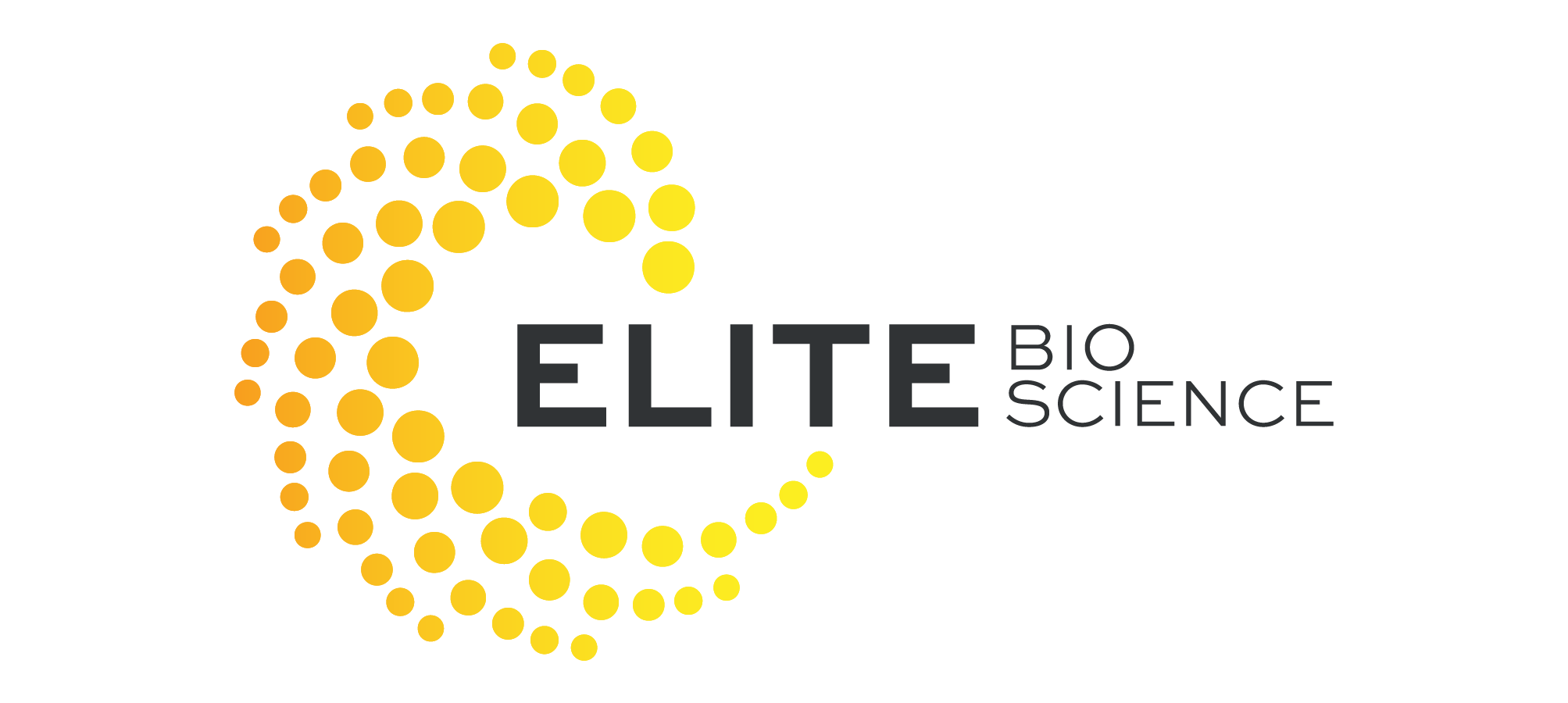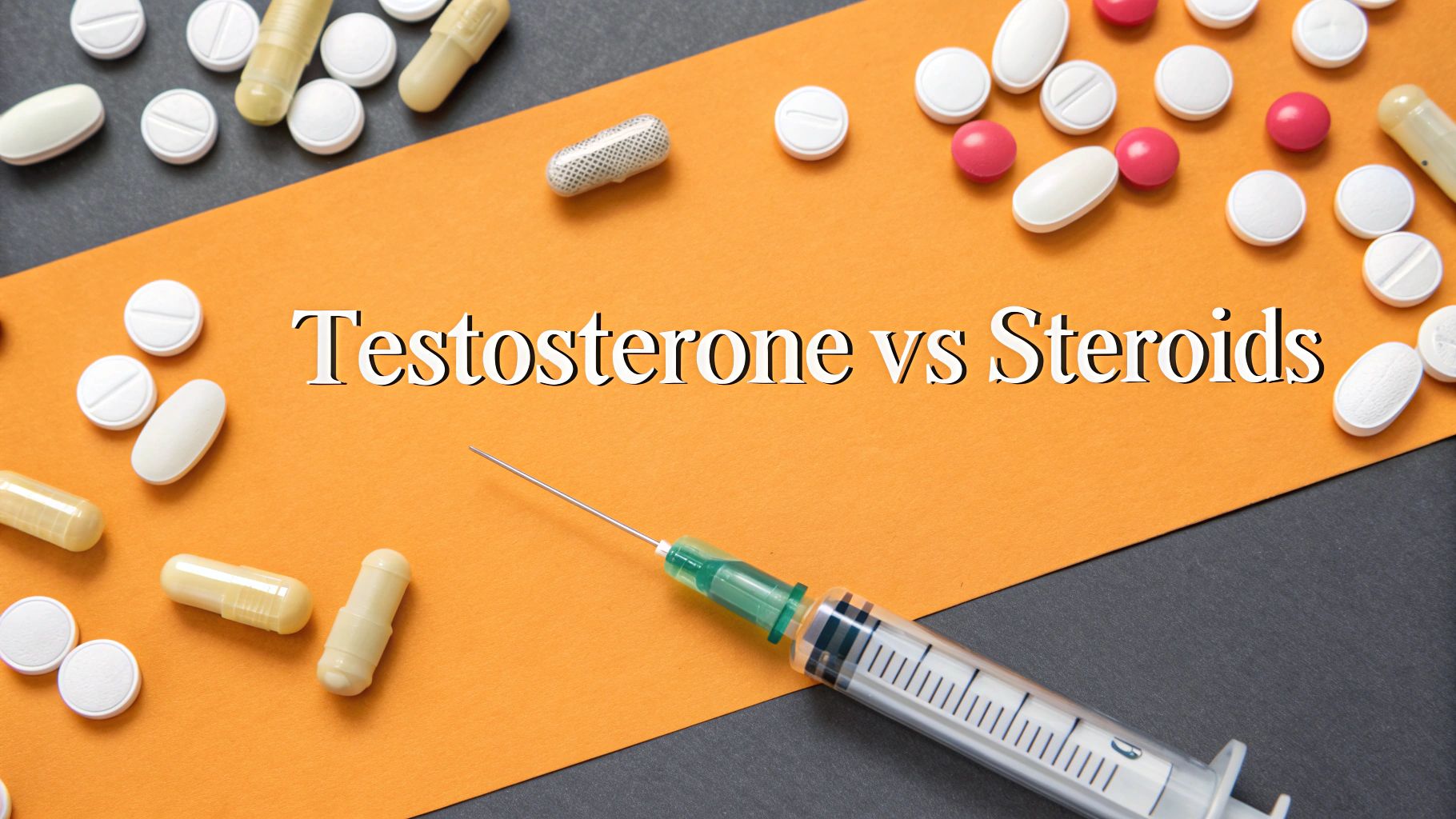How to Increase Growth Hormone Naturally: Top Tips & Tricks

If you want to naturally increase your growth hormone levels, it all comes down to your lifestyle. The most powerful levers you can pull are already within your control. The proven formula is a potent mix of high-intensity exercise, strategic nutrition (like intermittent fasting), and prioritizing deep, quality sleep.
These are the pillars that create the ideal environment for your body to ramp up its own HGH production.
Understanding Natural Growth Hormone Production
Human Growth Hormone (HGH) is a powerful substance made by your pituitary gland, a tiny but critical gland situated at the base of your brain. While most people associate it with childhood growth spurts, its job is far from over once you're an adult. Throughout your life, HGH acts as your body’s master repair signal, essential for maintaining healthy tissues, firing up your metabolism, and making sure your cells regenerate properly.
Think of it as the body's internal maintenance crew, working around the clock to keep everything running smoothly. Its production isn't a constant drip; instead, it's released in pulses, mostly during deep sleep and in response to intense physical stress like a tough workout. This pulsing rhythm is a key part of how it works.
The catch? HGH production peaks during adolescence and then starts a slow, steady decline once you hit your 30s. This is a totally normal part of aging, but a significant drop can really impact how you feel and perform, often leading to:
- Decreased muscle mass and strength
- Increased body fat, especially around the stomach
- Reduced bone density
- Lower energy levels and slower recovery from workouts
Why This Natural Decline Matters
This gradual reduction in HGH is one of the main reasons we start to see changes in our body composition and energy levels as we get older. The good news is, you have a massive amount of influence over this process. Your daily habits can either speed up this decline or help you preserve—and even boost—your natural HGH output, no matter your age.
The goal isn't to turn back the clock but to support your body’s built-in ability to produce this vital hormone. By focusing on natural methods, you empower your system to function at its best, promoting long-term health without needing external interventions.
This guide is your roadmap. We aren't going to talk about synthetic hormones or quick fixes. Instead, we'll dive into the most effective, evidence-backed strategies you can start using today.
Before we get into the nitty-gritty of the "how-to" sections, let's take a quick look at the core strategies we'll be covering.
Here's a quick look at the most effective strategies for boosting HGH, how they work, and the benefits you can expect.
Your Guide to Natural Growth Hormone Enhancement
| Strategy | How It Works | Primary Benefit |
|---|---|---|
| High-Intensity Exercise | Triggers a significant, short-term HGH release by pushing your body past its comfort zone. | Maximizes hormonal response for muscle growth and fat metabolism. |
| Intermittent Fasting | Lowers insulin levels, which can otherwise blunt the release of HGH. | Creates a favorable hormonal environment for HGH secretion. |
| Deep Sleep | The majority of your daily HGH is released during slow-wave sleep. | Allows for maximum natural hormone production and cellular repair. |
| Stress Management | Reduces cortisol, a stress hormone that can inhibit HGH production. | Protects your natural hormone balance and overall well-being. |
As you can see, each of these pillars plays a unique and critical role. By combining them, you create a powerful synergy that encourages your body to do what it does best: keep you strong, lean, and resilient.
Using High-Intensity Exercise for a Potent HGH Surge
A leisurely walk is great for clearing your head, but it won’t move the needle much on your growth hormone levels. To truly trigger a powerful HGH response, you need to embrace intensity. Pushing your body past its comfort zone sends a loud and clear signal to your pituitary gland: release a surge of HGH to handle repair and recovery.
This is exactly why short, demanding workouts crush long, steady-state cardio. Intensity, not duration, is the name of the game. You're aiming to create a metabolic stressor that forces your body to adapt, and HGH is a primary driver of that adaptation.
Why Intensity Trumps Duration
High-Intensity Interval Training (HIIT) is hands-down one of the most effective ways to get this done. HIIT is all about short bursts of maximum effort followed by brief recovery periods. This style of training creates a massive oxygen debt and lactate buildup—two of the most potent triggers for HGH secretion.
Likewise, heavy resistance training that recruits large muscle groups sparks a huge hormonal response. Think about compound movements like squats, deadlifts, and bench presses. They engage so much muscle fiber that they demand a robust recovery process fueled by HGH. The goal is to lift heavy enough to be a real challenge within the 6-10 rep range to maximize this effect.
Research backs this up completely. Studies show a single heavy resistance session can spike HGH levels by as much as 682% post-workout.
The takeaway is simple: your workout needs to be challenging enough that you can't hold a conversation during the intense parts. That "breathless" state is a solid indicator you've crossed the lactate threshold and are kicking off a major hormonal release.
Practical Examples of HGH-Boosting Workouts
Putting this into practice is surprisingly straightforward. You don't need to live in the gym; a focused 20-30 minute session can be incredibly powerful.
-
HIIT Sprint Session (Tabata Style): Hop on a stationary bike or find an open path. Go all out for 20 seconds of maximum effort, then take 10 seconds of complete rest. Repeat this 8 times. The whole thing takes just four minutes, but it’s brutally effective at spiking HGH.
-
Compound Lift Routine: Build a workout around 3-4 big, compound lifts. You could do 4 sets of 8 reps of Barbell Squats, move on to Dumbbell Bench Press, and finish with Bent-Over Rows. Just focus on good form and using a weight that makes those last couple of reps a genuine struggle.
Slotting these intense sessions into your week 2-3 times can significantly how to improve athletic performance and get you closer to your goals.
Sleep is another cornerstone for maximizing HGH. The infographic below highlights just how critical deep, restorative rest is for this process.

As you can see, creating an environment that promotes deep sleep is non-negotiable, as this is when the most significant HGH release of the day occurs.
Your kitchen is one of the most powerful tools you have for influencing your body's hormone production. What you eat—and just as importantly, when you eat—directly impacts your body’s ability to release growth hormone. Smart, consistent nutritional choices can create an internal environment where HGH can thrive.

This isn’t about extreme dieting or deprivation. Instead, it’s about understanding the relationship between food, insulin, and HGH, then using that knowledge to your advantage. A few key adjustments can make a significant difference.
Harnessing the Power of Intermittent Fasting
One of the most effective dietary strategies for boosting HGH is intermittent fasting (IF). When you fast, your insulin levels drop significantly. This is crucial because high insulin is known to blunt HGH secretion. By keeping insulin low for extended periods, you create a perfect window for your body to ramp up its growth hormone release.
The 16/8 method is a popular and sustainable starting point. You simply fast for 16 hours—most of which you're asleep—and eat all your meals within an 8-hour window. A common approach is to skip breakfast, have your first meal at noon, and then finish eating by 8 PM.
Studies have shown that fasting can cause a dramatic increase in HGH levels, sometimes by several hundred percent. This simple shift in meal timing can be a true game-changer.
Managing Sugar and Insulin Spikes
Beyond just when you eat, what you eat during your eating window matters immensely. High sugar intake and refined carbs cause sharp spikes in insulin, effectively slamming the brakes on HGH production. Consistently high insulin keeps your body in storage mode, which is the exact opposite of the repair-and-release state HGH promotes.
Your goal is to minimize foods that cause rapid blood sugar spikes. This means cutting back on sugary drinks, processed snacks, white bread, and pasta. Prioritizing whole foods helps keep your insulin levels stable and supports your entire hormonal system.
Making this change doesn’t have to be painful. You can start with simple swaps:
- Instead of soda or juice, try sparkling water with a squeeze of lemon.
- Instead of a sugary cereal, choose Greek yogurt with berries and nuts.
- Instead of white rice, switch to quinoa or brown rice.
These small adjustments really add up over time, creating a much more favorable environment for HGH release.
Incorporating HGH-Supportive Nutrients
Certain foods are packed with amino acids and other compounds that can give your body’s natural HGH production a helping hand. While no single food will magically boost your levels, weaving these nutrients into a balanced diet provides excellent complementary support.
Consider adding foods rich in specific amino acids:
- Arginine: Found in pumpkin seeds, nuts, and lean meats, arginine can help stimulate the pituitary gland.
- Glutamine: Present in spinach, cabbage, and fish, glutamine is another amino acid linked to HGH release.
- Melatonin: While known for sleep, melatonin-rich foods like tart cherries can improve sleep quality—which is prime time for HGH secretion.
By combining intermittent fasting, cutting back on sugar, and focusing on nutrient-dense whole foods, you create a powerful dietary framework. This approach doesn't just help you increase growth hormone naturally; it also supports overall metabolic health, energy levels, and well-being.
Mastering Your Sleep for Maximum HGH Release
Forget what you think you know about getting "enough" sleep. When it comes to maximizing Human Growth Hormone, it's not just about the hours you clock in; it’s about the quality of those hours. Your body’s most powerful surge of HGH doesn’t happen in the gym or at the dinner table—it happens deep in the silence of the night.
The vast majority of your daily HGH production is unleashed during the deep, slow-wave stages of sleep. This makes getting high-quality rest a non-negotiable pillar if you're serious about naturally boosting your levels.

Simply aiming for eight hours won't cut it if that time is spent tossing and turning. The real magic unfolds during Stage 3 sleep, also known as deep sleep. It’s during this incredibly restorative phase that your pituitary gland gets the green light to release its largest HGH pulses of the day.
Any interruptions—a car alarm, a notification buzz, a room that’s too warm—can pull you out of this crucial stage. Fragmented sleep directly sabotages your HGH production. That’s why dialing in your sleep habits is one of the most effective strategies you have.
Creating the Perfect Sleep Sanctuary
Your bedroom needs to become a cave: cool, dark, and quiet. It's that simple. Even tiny amounts of light can throw off your circadian rhythm and mess with melatonin, the hormone that tells your brain it's time for deep rest.
Temperature is another huge factor. A cooler room, somewhere around 65°F (or 18°C), helps your body's core temperature drop, which is a key signal for initiating sleep.
To build your sanctuary, get serious about these elements:
- Go Pitch Black: Invest in real blackout curtains or a high-quality sleep mask. Cover or remove any electronics that emit light. No excuses.
- Embrace Silence: If you live in a noisy area, earplugs or a white noise machine aren't just nice-to-haves; they're essential tools for protecting your deep sleep.
- Stay Cool: Set your thermostat to a comfortably cool temperature. This small change helps facilitate the natural drop in body temperature needed to fall—and stay—asleep.
It's the small, consistent disruptions that add up. That tiny blinking light on your charger or a thermostat set just a few degrees too high can be enough to keep you from hitting the deepest, most HGH-rich stages of sleep.
Winning the Battle Against Blue Light
Here’s a modern-day sleep killer: the blue light blasting from our phones, tablets, and computers. This specific wavelength is incredibly effective at tricking your brain into thinking it's still high noon, which slams the brakes on melatonin production and pushes back sleep.
The solution is straightforward, but it requires discipline. You need to establish a non-negotiable "no screens" rule for at least one hour before bed. Put the phone away. Close the laptop.
Use that last hour to do something that actually signals "rest" to your body, like reading a physical book, light stretching, or listening to calm music.
The Pre-Sleep Nutrition Trap
What you eat—and when you eat it—before bed can make or break your nighttime HGH pulse. A big meal, especially one loaded with refined carbs or sugar, is particularly destructive. Why? Because it causes a massive spike in insulin.
Think of high insulin as the arch-nemesis of HGH. When insulin levels are up, it sends a signal to your pituitary gland to stand down and hold off on releasing growth hormone. Timing this spike right before bed means you're blunting the most significant natural HGH release you get all day.
To sidestep this trap, make it a rule to finish your last meal at least 2-3 hours before you hit the pillow. If you're genuinely hungry later, reach for a small snack that’s low in carbs and higher in protein or healthy fats. This simple timing trick ensures your insulin is low when you drift off, clearing the runway for a powerful HGH surge.
Navigating Supplements For Natural HGH Support
While the core pillars of exercise, diet, and sleep are your most powerful tools, certain supplements can act as valuable allies in your quest to increase growth hormone naturally. It’s crucial to see them not as magic pills but as supportive players. They enhance the effects of your consistent lifestyle efforts.
Think of it this way: your lifestyle creates the big picture, and a well-chosen supplement can help sharpen the details. These compounds work by targeting specific biological pathways, like improving sleep quality or providing the amino acid building blocks your body needs to get the job done.
Key Supplements and Their Mechanisms
It’s easy to get lost in a sea of marketing hype when you start exploring options. The smartest approach? Focus on compounds with established biological roles. Some of the most studied and promising supplements are amino acids, which are directly involved in bodily processes that can influence HGH release.
Here are a few that have shown real potential:
- Arginine: This amino acid may boost HGH release by inhibiting somatostatin, a hormone that actively blocks HGH production. It's often taken before workouts to amplify the exercise-induced HGH spike.
- GABA (Gamma-Aminobutyric Acid): Known primarily for its calming effects on the nervous system, GABA may also stimulate the pituitary gland to release more HGH. Its ability to promote relaxation is a double win, as it can lead to better sleep—a key factor for those crucial nighttime HGH pulses.
- Glutamine: As the most abundant amino acid in the body, glutamine is a powerhouse for recovery and immune function. Some research suggests it can create a temporary HGH spike right after you take it.
It's important to remember that the effects of these supplements can be modest and highly individual. They are designed to support your body's natural processes, not override them.
Melatonin For Deeper Sleep and HGH Release
Melatonin stands out because its primary role is directly tied to the single most important window for HGH release: deep sleep.
As a hormone that regulates your sleep-wake cycle, supplementing with melatonin can help you fall asleep faster and achieve more time in those restorative, slow-wave stages of sleep where HGH production truly peaks. By improving your sleep architecture, you're directly creating a more favorable environment for your body's most significant HGH pulse. Even a small dose can make a noticeable difference in sleep quality for some people.
Making Informed and Safe Choices
The supplement industry is notorious for products with exaggerated claims. To avoid wasting money and protect your health, always scrutinize labels. Be wary of proprietary blends that hide individual ingredient dosages—that's a major red flag.
The best approach is to start with a single-ingredient supplement at a low dose to see how your body responds.
Before adding anything new to your routine, it's essential to talk to a healthcare professional. They can help you understand potential interactions and determine if a supplement is appropriate for your individual health profile. For a deeper dive, you can explore our guide to the top supplements to boost HGH levels for a more detailed breakdown.
Your Questions Answered: What to Expect on Your HGH Journey
Starting a journey to naturally boost your growth hormone is bound to bring up some practical questions. Knowing what to expect and understanding the details can make all the difference in staying consistent and feeling confident. Let's dig into some of the most common things people ask.
How Long Does It Take to Notice Changes?
While you'll get an immediate HGH spike right after a killer high-intensity workout, the bigger benefits—like a leaner body or more energy—take a bit more time. You should start to see and feel tangible changes after a few weeks to a few months of sticking with it.
Think of it like building momentum. A single great workout gives you a temporary lift, but a solid month of quality sleep, clean eating, and intense training is what really creates a lasting shift. The results stack up over time, so patience and consistency are your best friends here.
The key isn't perfection, it's persistence. Don't get discouraged if you don't see a major difference in the first week. The goal is to build sustainable habits that support your hormonal health for the long haul.
Can I Still Increase Growth Hormone Effectively After 50?
Absolutely. It’s true that HGH production naturally winds down as we get older, but the strategies in this guide are still incredibly effective. In fact, they become even more critical for fighting off age-related muscle loss and a slowing metabolism. The core principles work at any age.
For anyone over 50, resistance training is a true game-changer for firing up HGH and holding onto strength and vitality. Likewise, a low-sugar diet and making sleep a priority are powerful tools, no matter how old you are. Your body never loses its ability to respond to these positive signals.
Is Intermittent Fasting Safe for Everyone?
Intermittent fasting can be a fantastic tool for a lot of people, but it’s definitely not a one-size-fits-all solution. Listening to your body is everything. If you find yourself feeling consistently unwell, dizzy, or weak, that's a clear sign to shorten your fasting window or try a different approach.
It’s always best to talk to a doctor before starting if you are pregnant, breastfeeding, have a history of eating disorders, or are managing a condition like diabetes. For some people, other nutritional strategies will be a better and safer fit. Your well-being has to come first.
Since optimizing one hormone often impacts others, many people also look for ways to support their other key players. For those interested, you can learn more about how to increase testosterone naturally in our detailed guide.
At Elite Bioscience, we believe in empowering you with therapies that complement your healthy lifestyle choices. Our clinically-supported treatments are designed to help you reach your full potential, with guidance and products delivered right to your door.
Discover how our tailored therapies can support your health goals today.
QUICK SEARCH
Make an account today to start your journey towards a better and healthier lifestyle.






